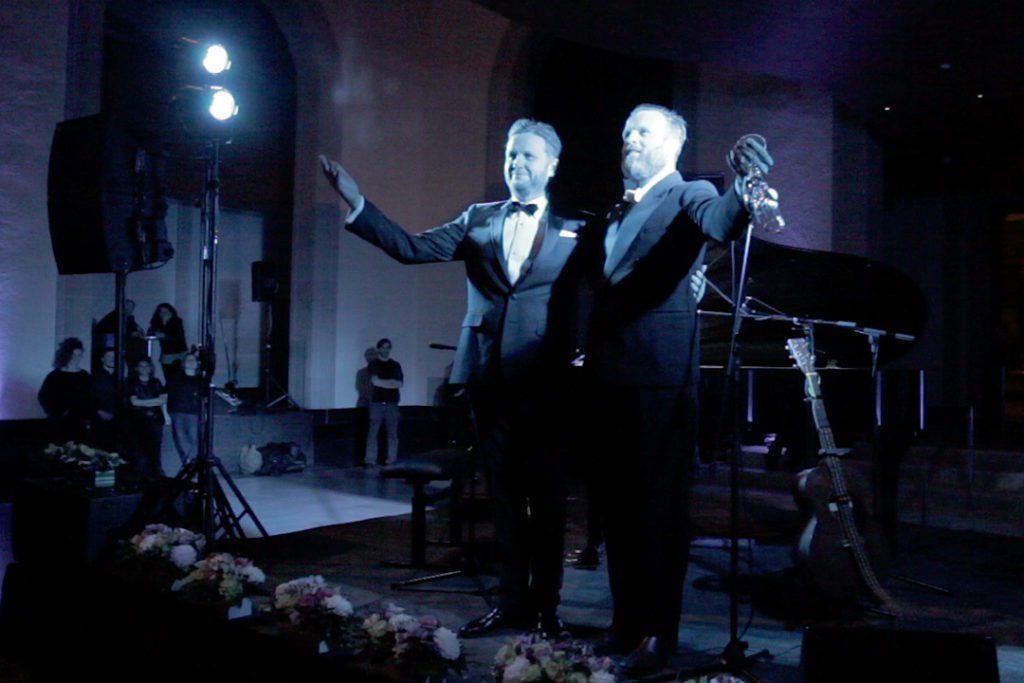As part of Villa Toronto’s opening-night celebrations, the Art Gallery of Ontario partnered with Reykjavik’s i8 Gallery to present An Evening of Misery, a musical performance by internationally acclaimed artist Ragnar Kjartansson. The event was scheduled to follow Villa Toronto’s opening-night party at Union Station. At 10 p.m., ticket-holders were ushered in to Walker Court, the airy ground-level atrium located at the heart of the AGO. At the centre of the room, tinged with blue light and positioned under the magnificent Frank Gehry–designed swirling staircase, a flower-ringed stage was set with a piano, a microphone stand and two guitars.
Kjartansson and his frequent collaborator Davíð Þór Jónsson arrived on stage in tuxedos, with two champagne flutes and a bottle of Moët in hand. They opened their two-hour set with songs by the Louvin Brothers, an American country-music duo, active from the 1940s to the early 1960s, who were as famous for their close-harmony gospel singing as they were for their drinking, womanizing and abusive behaviour. Kjartansson and Jónsson also performed two of Townes Van Zandt’s very saddest songs—“Kathleen” and “Tecumseh Valley”—and described the cult musician as “a Texas songwriter who lived in a trailer, sniffed glue, ate microwaved food and died way too young…he wrote most of his songs in motels with the blinds closed all day and all night so he wouldn’t know if it was night or day.”
Most of the heart-wrenching and soul-shattering songs that Kjartansson chose for this performance were penned either by Americans of a Southern pedigree or by 19th-century German Romantics. Artistically, these two groups are perhaps the most qualified and experienced in matters of self-pity (in a triumphant proclamation, Kjartansson named Schumann’s Dichterliebe “the national anthem of the arts!”). As he sang of Sehnsucht, tragedy and good old-fashioned hard luck, the artist appeared to become progressively more inebriated, eventually climbing onto Jónsson’s piano stool and discarding his clothing—to reveal tuxedo-print underpants.
Kjartansson finished the show in this state of undress, and was joined onstage during a heartbreaking rendition of Dolly Parton’s “I Will Always Love You” (“the most brutal break-up song ever written”) by local musician Joseph Shabason, who made his way through the crowd—shirtless, in ripped and bleached denim—to provide a wailing saxophone accompaniment. As Kjartansson shot showers of colourful confetti into the cheering crowd, his promise of a most melancholy evening dematerialized, thwarted by an intentionally self-sabotaging display of over-the-top camp theatricality. Following an opening-night event at Union Station that felt slightly unsure of its aims, it was a pleasure to wallow in the bittersweet misery of an artist who knew just what he was doing.
Ragnar Kjartansson: An Evening of Misery from Canadian Art on Vimeo.

 Ragnar Kjartansson and Davíð Þór Jónsson, An Evening of Misery, 2015. Walker Court, AGO.
Ragnar Kjartansson and Davíð Þór Jónsson, An Evening of Misery, 2015. Walker Court, AGO.







